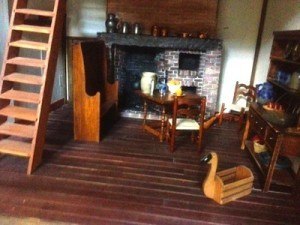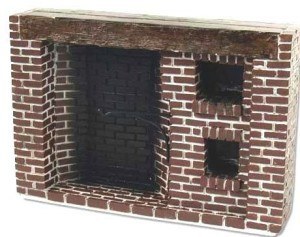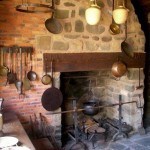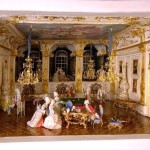
Reconstruction of a colonial kitchen at Williamsburg
Colonial Kitchens
The colonial period is a favorite among miniature enthusiasts. Unfortunately, some of us don’t sweat the small stuff when we try our first period-piece. Let’s look at the basics of the colonial kitchen.
Since the cavemen left the cave, dealing with fire became first on the list when building a shelter. The same was true with the colonial home, both to keep warm in the long northern winters, and in designing the cooking facility.
The Hearth
In early colonial days (from 1607-1699), they used open-hearth cooking in a straight-walled fireplace. The oven was at the back, with a carved wooden door cut to fit. The wealthy used an iron door, which survived longer than wood and reflected heat into the room.
Furnishings
Furnishings consisted of a trestle table, which could be dismantled and set against the wall to provide more workspace in the single room. Along one wall there could be a board set on a chest or a crude frame for food preparation.
Shelves were mortised into corner posts. No curtains, no rugs, one chair for the man of the house, one or two benches for the wife and children, stools, a spinning wheel, possibly a food or pie safe. (see the picture above of the full-sized Williamsburg reconstruction).
You would see tubs for washing, but no sinks, dry or otherwise. Pots and pans were cleaned by singing them with fire, or sometimes sand was used as an abrasive. This is not so far-fetched. When I went hiking with the Girl Scouts, water could be scarce in the high mountains. We used dirt to clean dishes and dusted them off with our shirttails. My mother was mortified when she heard about it; my aunt, not so much. She waved it off with, “We all eat a peck of dirt in our lifetime, anyway.”
Late Colonial
In the late colonial period (1700-1776) it was much the same, but there were some design improvements. The fireplace now had slanted walls to reflect heat. The oven had been moved to the front where it was handier and safer. (as in the picture of the walk-in fireplace on Jenn’s Mini World).
The walls were covered with a lime wash to reflect light. Almost everyone had a food or pie safe to protect edibles from vermin. Mop boards – what we now call baseboards – were in most homes.
And if you did not have a long-legged stand called a Bible Box to hold the family Bible, you risked getting stern looks from visitors.
Susan Downing, with Patrick Owens
_____________________________________________________________________________________
I invite you to visit my Etsy Shop where I offer many accessories and pieces of furniture in 1:12 scale.







